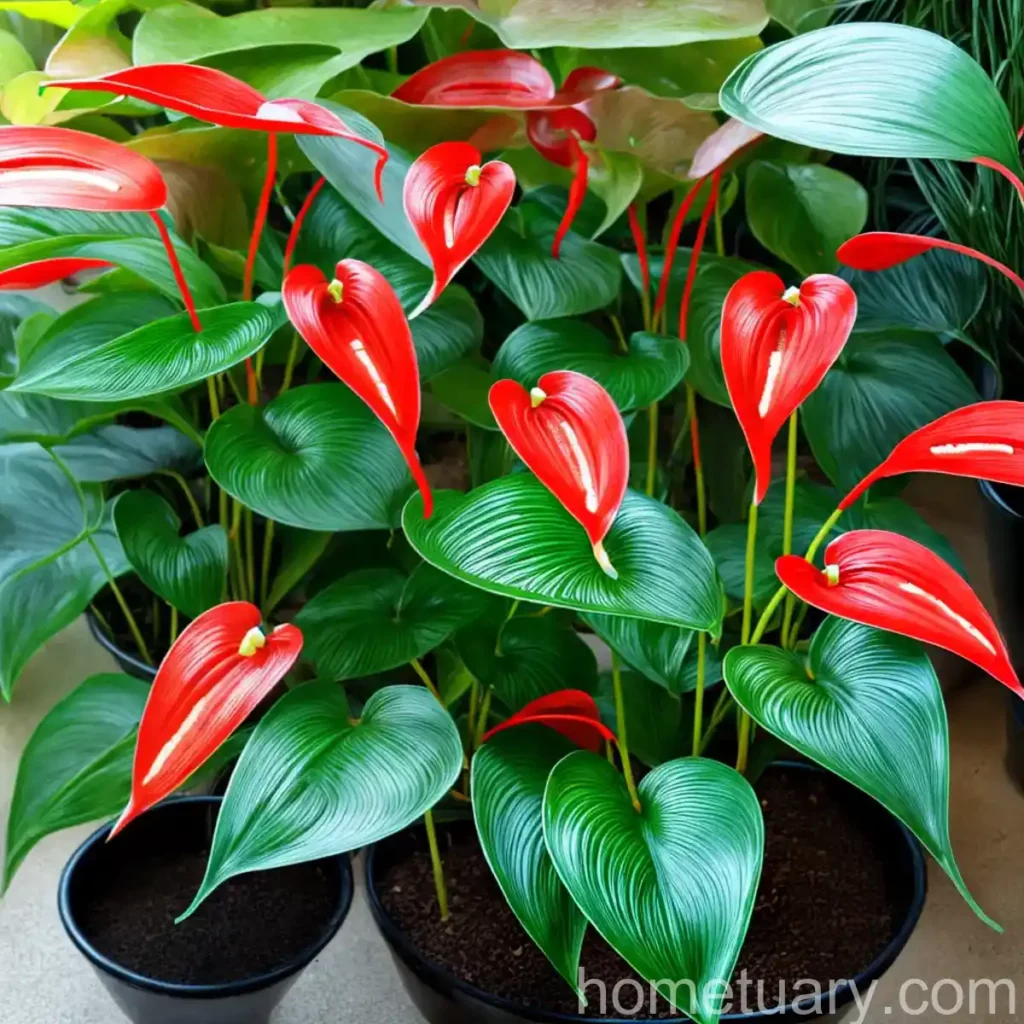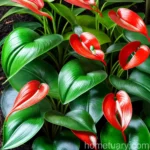Anthurium: A Comprehensive Guide
Anthurium, scientifically known as Anthurium andraeanum, is a captivating and vibrant genus of plants that belongs to the Araceae family. Renowned for its distinctive heart-shaped, glossy leaves and striking, colorful spathe, the Anthurium is a popular choice for indoor and outdoor ornamental planting. In this comprehensive guide, we will explore the various facets of Anthurium care, cultivation, uses, and maintenance. From understanding its symbolism to delving into its propagation and common pests, this guide will equip both novice and seasoned plant enthusiasts with valuable insights into the world of Anthuriums.
What is Anthurium (Anthurium andraeanum)?
Anthurium, derived from the Greek words “anthos” meaning flower and “oura” meaning tail, is aptly named due to the unique appearance of its inflorescence. Also known as the flamingo lily or painter’s palette, Anthurium is native to the tropical regions of Central and South America. The genus comprises over 1000 species, with Anthurium andraeanum being one of the most popular and widely cultivated varieties.
Anthuriums are prized for their ornamental value, with their vibrant, heart-shaped spathes (colored leaf-like bracts) and distinctive spadices, which are the flowering spike. The spathe comes in an array of hues, including red, pink, white, and orange, effortlessly adding a pop of color to any setting. Beyond its visual appeal, Anthuriums are renowned for their air-purifying capabilities, making them an excellent choice for indoor spaces.
Key Takeaways – Anthurium (Anthurium andraeanum)
Before delving into the specific aspects of Anthurium care and cultivation, let’s highlight the key takeaways that will be covered in this guide.
- Anthurium symbolism
- Anthurium care guide
- Anthurium types
- Anthurium flower arrangement
- Anthurium indoor plants
- Anthurium plant care tips
- Anthurium plant diseases
- Anthurium plant fertilization
- Anthurium plant pests
- Anthurium plant propagation
- Anthurium flower colors
- Anthurium plant pruning
- Anthurium watering needs
- Anthurium plant potting mix
- Anthurium plant benefits
- Anthurium plant toxic to pets
- Anthurium plant natural habitat
- Anthurium plant health benefits
- Anthurium plant common problems
- Anthurium plant growth stages
- Anthurium plant sunlight requirements
- Anthurium plant temperature preferences
- Anthurium plant humidity needs
- Anthurium plant air purification
- Anthurium plant common names
- Anthurium plant species diversity
- Anthurium plant uses in landscaping
- Anthurium plant life cycle
- Anthurium plant blooming season
- Anthurium plant stunning varieties
- Anthurium plant pot selection
- Anthurium plant container gardening
- Anthurium plant shelf decoration
- Anthurium plant natural remedies
- Anthurium plant decorative gift ideas
- Anthurium plant home decor
- Anthurium plant distinctive characteristics
- Anthurium plant diseases and treatments
- Anthurium plant cold weather care
- Anthurium plant humidity solutions
- Anthurium plant light requirements
- Anthurium plant water requirements
- Anthurium plant root care
- Anthurium plant leaf problems
- Anthurium plant flower maintenance
- Anthurium plant common care mistakes
- Anthurium plant pests and control measures
- Anthurium plant fertilizer recommendations
- Anthurium plant placement tips
- Anthurium plant repotting guidelines
Now, let’s immerse ourselves in the world of Anthuriums by exploring the various aspects of its culture, uses, maintenance, and more.
Culture
Cultivating Anthuriums is a rewarding experience, provided the necessary environmental conditions and care are provided. Understanding the cultural requirements of Anthurium is paramount in ensuring the plant thrives and flourishes. Let’s delve into the cultural considerations for Anthuriums.
Water
Anthuriums thrive in a humid environment and require consistent moisture to thrive. However, overwatering can lead to root rot, while underwatering can cause the plant to wilt and decline.
Watering Needs:
- Water the Anthurium when the top inch of the soil feels dry to the touch.
- Avoid waterlogging and ensure good drainage to prevent root rot.
- Use tepid water or let cold water reach room temperature before watering to avoid shocking the plant.
Sunlight
Proper sunlight exposure is essential for the healthy growth of Anthuriums. They thrive in bright, indirect light and can tolerate moderate shade. However, excessive exposure to direct sunlight can scorch the leaves and cause sunburn.
Sunlight Requirements:
- Place Anthuriums in locations with bright, indirect light, such as near east or north-facing windows.
- Shield them from direct sunlight, especially during the intense afternoon hours.
- In low-light conditions, consider supplementing with grow lights to ensure adequate light exposure.
Fertilizer
Fertilizing Anthuriums is crucial to support their growth and promote flowering. A balanced, water-soluble fertilizer with a higher phosphorus content is ideal for Anthuriums, promoting robust foliage and vibrant blooms.
Fertilization Tips:
- Feed Anthuriums with a balanced liquid fertilizer every 6-8 weeks during the growing season (spring and summer).
- Dilute the fertilizer to half the recommended strength to prevent over-fertilization.
- Cease fertilization during the plant’s dormancy period in fall and winter.
Soil
Quality soil is essential for Anthuriums, providing a well-draining, aerated medium that supports root health and growth. A porous, well-draining potting mix with excellent moisture retention is ideal for Anthuriums.
Potting Mix:
- Use a loose, well-aerated potting mix rich in organic matter, such as peat moss, perlite, and pine bark.
- Ensure the potting mix offers good drainage to prevent waterlogging and root rot.
- Consider adding charcoal to the mix to enhance drainage and prevent soil compaction.
Pruning
Pruning is a vital aspect of Anthurium maintenance, promoting a tidy appearance and stimulating healthy growth. It involves removing spent blooms, yellowing leaves, and any damaged or diseased foliage.
Pruning Tips:
- Use clean, sharp shears to prune Anthuriums to minimize the risk of introducing pathogens.
- Remove faded blooms, yellowing leaves, and any pest-infested foliage promptly.
- Prune stems to encourage branching and promote bushier growth.
Propagation
Propagating Anthuriums offers an opportunity to expand your plant collection and share these stunning specimens with fellow plant enthusiasts. Anthuriums can be propagated through division and stem cuttings.
Propagation Methods:
- Division: Carefully separate the rhizomes to create divisions, ensuring each division has healthy roots and foliage.
- Stem Cuttings: Select a healthy stem with several leaves and aerial roots, then make a clean cut below a node. Place the cutting in a moist, well-draining medium to encourage root development.
Container
Selecting the right container for Anthuriums is crucial, providing a stable and suitable environment for the plant’s growth. Choose a container that accommodates the plant’s root system and offers adequate drainage.
Container Tips:
- Opt for a container with drainage holes to prevent waterlogging and ensure proper drainage.
- Select a pot that allows for sufficient space for the roots to spread and grow.
- Consider using a decorative container or pot cover to complement the plant’s aesthetic appeal.
Uses
Anthuriums are esteemed for their versatile uses, ranging from ornamental decoration to their subtle air-purifying properties. Let’s explore the diverse applications of Anthuriums.
-
Ornamental Display: Anthuriums are widely used as ornamental plants to adorn indoor and outdoor spaces, adding a touch of elegance and color to the surroundings. Their vibrant blooms and glossy foliage make them a popular choice for floral arrangements and decorative displays.
-
Air-Purifying Qualities: Anthuriums are recognized for their air-purifying capabilities, effectively filtering out airborne toxins and enhancing indoor air quality. They are often included in interior landscapes to promote a healthier living or working environment.
-
Gifting and Decor: Anthuriums are often presented as gifts due to their captivating blooms and lasting appeal. Their longevity and low maintenance make them an ideal choice for gifting on various occasions, from birthdays to housewarmings.
-
Landscaping: In tropical and subtropical regions, Anthuriums are utilized in landscaping to add lush, vibrant accents to gardens, parks, and public spaces. Their striking appearance and resilient nature make them a valuable addition to outdoor landscapes.
Popularity
Anthuriums have garnered widespread popularity and acclaim, captivating plant enthusiasts, florists, and interior decorators with their exotic allure and enduring beauty. Their popularity can be attributed to several factors, including their vibrant blooms, low maintenance requirements, and versatile uses. Anthuriums have become a staple in both indoor and outdoor horticulture, adorning homes, offices, and public spaces with their striking presence.
Common Diseases
Anthuriums, like many plants, are susceptible to certain diseases that can hinder their growth and vitality. Understanding common diseases afflicting Anthuriums is vital in implementing preventive measures and appropriate treatments. Let’s examine some of the common diseases that may affect Anthuriums.
| Disease | Symptoms | Treatment |
|---|---|---|
| Root Rot | – Yellowing and wilting of leaves | – Ensure proper drainage and avoid overwatering. – Repot in well-draining soil. – Trim affected roots and promote drying. |
| Leaf Spot | – Dark, water-soaked spots on leaves | – Remove and dispose of affected leaves. – Ensure adequate air circulation. – Apply a suitable fungicide if needed. |
| Botrytis Blight | – Gray mold on flowers and foliage | – Remove and discard affected plant parts. – Improve air circulation and reduce humidity. – Apply a fungicidal spray as needed. |
Disease Diagnosis
Diagnosing diseases in Anthuriums involves close observation of the plant’s symptoms and signs of distress. By identifying specific indicators and patterns, it becomes easier to pinpoint the underlying issue and initiate the appropriate course of action.
-
Root Rot Diagnosis: If the Anthurium displays wilting, yellowing leaves, and mushy, dark roots, it is likely suffering from root rot. The distinctive odor of rotting roots may also be present.
-
Leaf Spot Diagnosis: Dark, circular lesions on the leaves, often surrounded by a yellow halo, are indicative of leaf spot disease. The spots may vary in size and can lead to leaf discoloration and defoliation if left unchecked.
-
Botrytis Blight Diagnosis: A fuzzy, gray mold on the flowers and foliage of the Anthurium signals the presence of Botrytis blight. The affected plant parts may appear water-soaked and develop a decaying appearance.
Common Pests
Anthuriuums are occasionally targeted by pests that can compromise their health and vigor. Implementing pest management strategies is essential in safeguarding the plants from infestations. Let’s explore some of the common pests that may occur on Anthuriums.
| Pest | Symptoms | Control Measures |
|---|---|---|
| Aphids | – Clusters of small, soft-bodied insects on new growth and underside of leaves | – Use insecticidal soap or neem oil to control aphid populations. – Encourage natural predators like ladybugs and lacewings. – Physically remove aphids with a gentle stream of water. |
| Spider Mites | – Fine webbing and stippling on leaves | – Apply a miticide to manage spider mite infestations. – Increase humidity to create an unfavorable environment for spider mites. – Prune and dispose of heavily infested plant parts. |
| Mealybugs | – White, cottony masses on stems and leaf joints | – Dab mealybugs with a cotton swab dipped in rubbing alcohol to eliminate them. – Use insecticidal soap or neem oil for persistent infestations. – Inspect and isolate affected plants to prevent further spread. |
Botanist’s Tips
Drawing from insights and expertise, seasoned botanists offer valuable tips and recommendations for cultivating and caring for Anthuriums. These insights encompass best practices, troubleshooting advice, and proactive measures to ensure the optimal health and growth of Anthuriums.
-
Humidity Control: Maintain adequate humidity levels, especially for indoor-grown Anthuriums, by using a humidifier or group plants to create a microclimate.
-
Adequate Drainage: Ensure proper drainage by using well-draining soil and containers with drainage holes to mitigate the risk of waterlogged roots.
-
Regular Inspection: Routinely inspect Anthuriums for signs of pests, diseases, or nutrient deficiencies, addressing any issues promptly to prevent escalation.
-
Prudent Watering: Practice mindful watering to prevent overwatering or underwatering, adhering to the plant’s specific moisture requirements.
Fun Facts
- The Anthurium flower is essentially a modified leaf known as a spathe, which can come in a diverse range of vibrant colors and hues.
- Anthuriums are often used in floral arrangements and bouquets, adding a tropical and exotic touch to the ensemble.
- The Anthurium plant is prized for its air-purifying qualities, making it an ideal addition to interior landscapes.
- In their natural habitat, Anthuriums often grow as epiphytes, flourishing on tree branches and mossy surfaces.
Links to External Resources
To further expand your knowledge and understanding of Anthuriums, explore the resources below for in-depth insights and guidance.
- Anthurium Care Guide – The Spruce
- Anthurium Plant Care Tips – Gardenista
- Anthurium Plant Diseases and Treatments – Gardening Know How
- Anthurium Plant Propagation – Houseplant Central
- Anthurium Flower Colors and Varieties – Gardening Channel
- Anthurium Plant Sunlight Requirements – The Spruce
Anthuriums encompass a captivating blend of beauty, resilience, and versatility, making them a treasured addition to any plant collection or landscape. By understanding their cultural requirements, uses, and maintenance needs, you can foster thriving Anthuriums that bring a touch of tropical splendor to your surroundings. Embrace the allure of Anthuriums and immerse yourself in the rewarding world of vibrant foliage and stunning blooms.















